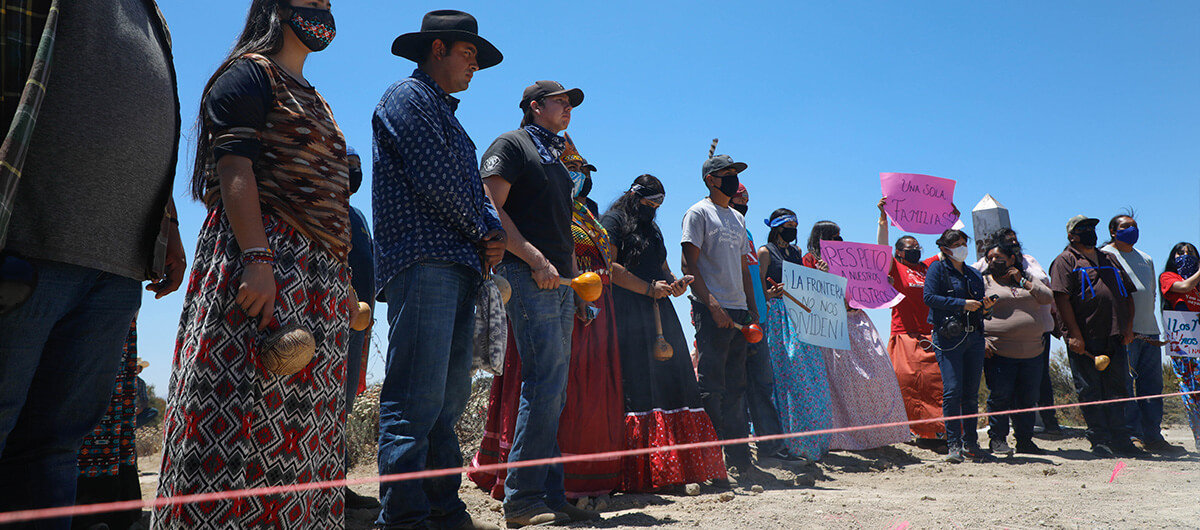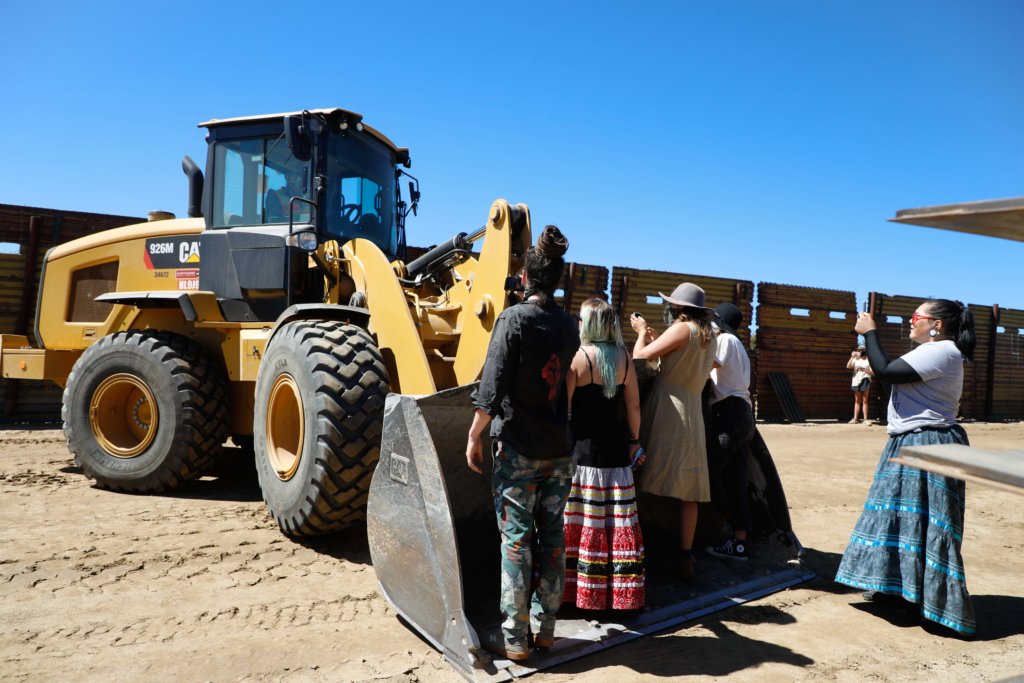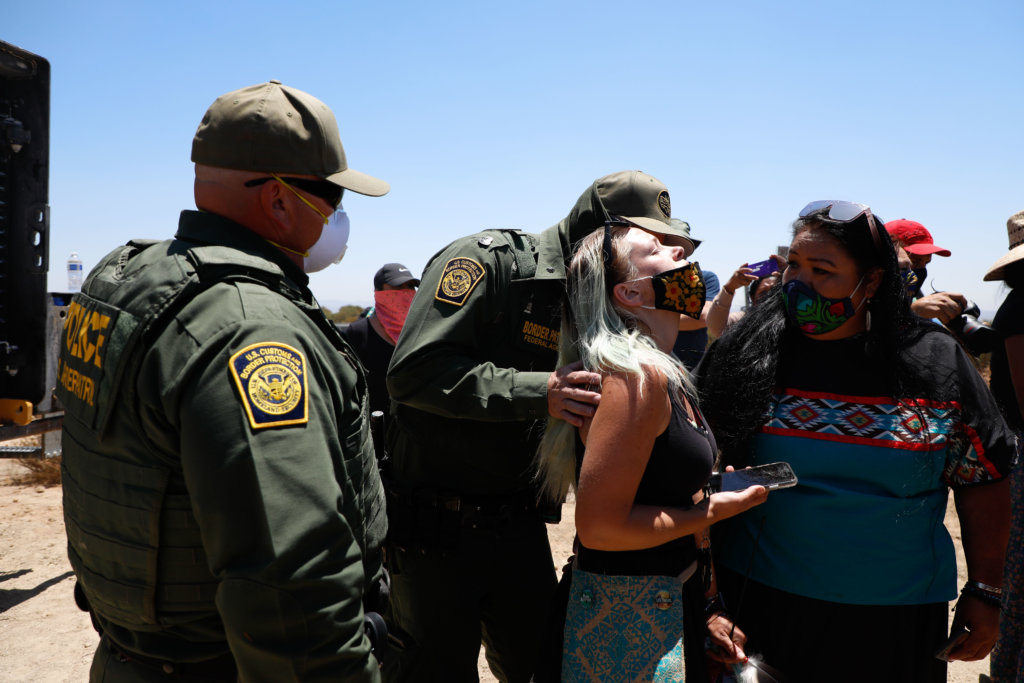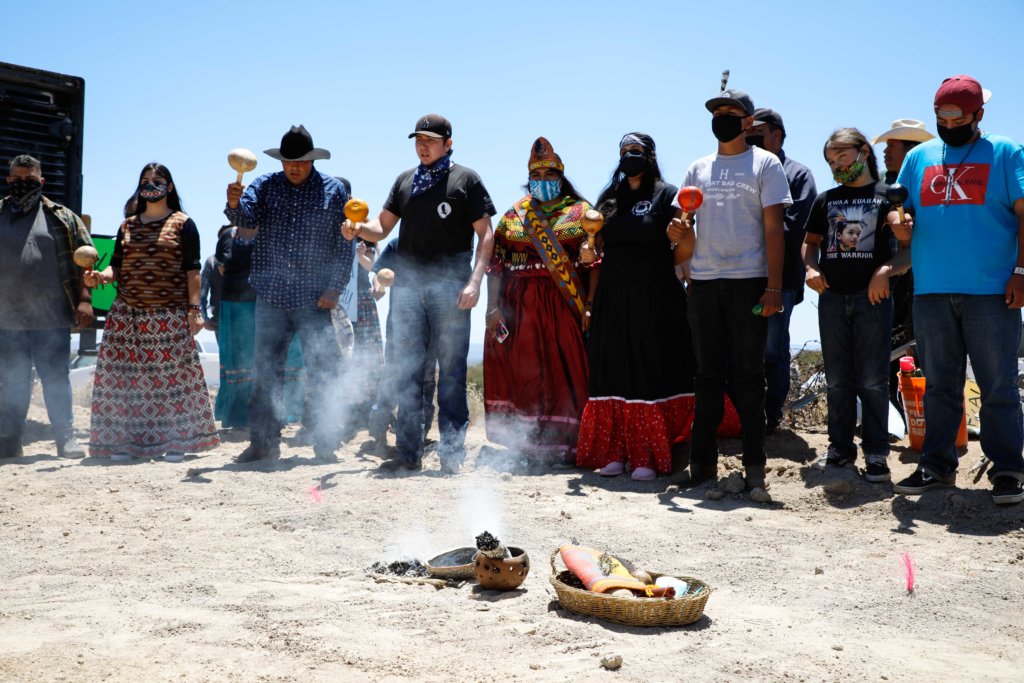
At the U.S-Mexico border, Kumeyaay Nation is fighting to protect their sacred land from the Trump administration
This article was made possible because of the generous support of DAME members. We urgently need your help to keep publishing. Will you contribute just $5 a month to support our journalism?
The American Border Patrol arrived en masse. The Department of Homeland Security circled overhead in a low-flying helicopter; a thunder reverberated through the air, chopping through the dusty ground. A forklift began to replace the empty borderline with the rusty and ridged pieces of the former border wall, closing the latitude of expansive land on either side of the Kumeyaay. A bulldozer parked a few feet away hummed loudly, its driver awaiting instruction. The Mexican military suddenly appeared from behind the flimsy blockade of Vietnam-era metal squares; a soldier at the helm of a machine gun. All the while, the bands of Kumeyaay Nation continued to pray. Their chants rang through the air, musical gourds rattling like a rhythmic rainstorm, while sage burned ceremonially. They danced with a mixture of joy and sorrow, and a tribe member placed a hand over her heart, dancing, as silent tears rolled down her face.
This was the scene on July 23, 2020 at the U.S.-Mexico Border, where Indigenous Americans are fighting to protect their land. The Kumeyaay believe the construction of the border wall—which includes the use of explosives—is destroying sacred land and desecrating the remains of their ancestors, essentially imploding graves. Jeff Stephenson, supervising agent for the U.S. Border Patrol’s San Diego sector has stated that, “no biological, cultural, or historical sites were identified within the blasting area.” The last sweep for artifacts was conducted on June 29, 2020, wherein an archeologist ally discovered remains of a human scapula.
The Kumeyaay states they require a cultural monitor prior to construction on their land, as is required for federally recognized tribes according to the Native American Graves Protection and Repatriation Act, and claims that the Border Patrol has not honored that. Unfortunately, for Native American tribes, the Trump administration has been able to bypass this protection through the 2005 Real ID Act, claiming it interferes with national security.
An hour or two prior on the American side of the border, tribal members—some adorned in traditional native clothing, some in streetwear, some bearing symbols of their heritage, including beaded necklaces, face paint, or hand-sewn Kumeyaay masks—hiked the dirt-laden landscape to the point where an obelisk stands, declaring the boundary of the United States. There, they were greeted by fellow members of the Kumeyaay; family, standing on the Mexican side of the border. They were each, respectively, unable to cross the simultaneously declared—yet invisible line—to be together. The Kumeyaay faced each other in parallelity, and the longing to greet one other in a genuine fashion was palpable. A couple of tribespeople from opposite sides of the border dared to embrace at the line, only to be scolded by a Border Patrol agent as a “security risk.”
The Kumeyaay have inhabited what are now known as Southern California and Northern Mexico for thousands of years. In publicly available maps, Kumeyaay Nation encompasses the border of the Pacific, stretching from Oceanside, California all the way down to Ensenada, Mexico, and extending east to the Colorado River. Evidence of settlement in Kumeyaay territory may date back 12,000 years, although it is a Kumeyaay belief that they have inhabited the land since the beginning of time. The Kumeyaay are known historically for creating sophisticated systems of agriculture, harvesting medicinal herbs, and for their basket weaving and pottery work. The idea of being American or Mexican doesn’t resonate with tribal members, as their nation predates the formation of either. They have been described by archeologists as “San Diego’s First People.”
The U.S.-Mexico border has cut through Kumeyaay land since 1848. There are 13 bands of the Kumeyaay in Southern California and six in Mexico. “We used to walk across this land for ceremonies and funerals every year. This is Kumeyaay Nation,” said Martha Rodriguez, a protest leader and member of the San Jose de la Zorra band of Kumeyaay. “We can’t see our families unless they get a passport or a green card to cross the land. This is our land.”
Multiple members of various tribes have stated that neither the Kumeyaay of Southern California or Mexico were informed of the wall-building on their land. This claim was also made in February by members of the Tohono O’odham Nation of Arizona. In 2000, the Clinton Administration signed Executive Order 13175 to prevent the “imposition of unfunded mandates upon American tribes,” and implementing government-to-government consultation. But as of May 15, 2020, the Trump administration signed its 25th waiver of federal laws, making for a record-breaking 30 waivers, including five signed during the Bush administration, essentially negating all protections—Native, environmental, and otherwise—at the border. The wall is being built at a record pace, and President Donald Trump’s reelection would almost guarantee its completion across Native land.
The Kumeyaay began to protest the building of the border wall on July 1. Each day, they pray for hours, undeterred by the repeated resistance they face from construction workers, Border Patrol, sheriffs, Homeland Security, and the Mexican military. The Kumeyaay and allies have stood atop construction equipment, blocked dirt pathways, and stood in front of sites where blasting was scheduled. And there have been a number of days, culminating into weeks, where they have successfully been able to halt the construction.
At a recent demonstration, Kumeyaay and allies parked their vehicles in front of a construction path in order to block equipment from entering. In turn, construction workers encircled protestors and observers, including the photographer for this story, with a dump truck and bulldozer for up to an hour, trapping them unprepared in the heat of the desert sun. It is unclear who instructed the construction workers to act in this manner, although a tribal member claims the construction foreman was the perpetrator. He also stated there was an exchange where protestors asked the foreman, “Are you guys gonna get off our land now?” To which the construction foreman replied, “This is the government’s land.”
“We need to protect [our ancestors]. It’s time for the government to listen,” Rodriguez stated. “We have harmony with land, and they are destroying native plants and killing animals. We have been here since the dawn of time, that’s why we’re here.” When asked what being Kumeyaay means to her, she replied, “We are not a museum relic or somebody’s mascot. We’re a very proud, very strong people.”
And every day, they show up. In a movement led entirely by women, including Councilwoman Cynthia Parades of the La Posta band of Mission Indians, Kumeyaay and allies on the American side of the border arrive at a casino as early as 4:30 a.m. A prayer is performed, and then a caravan of cars forms across the desert to find the construction location, while a member of border patrol follows behind on an ATV. The days are filled with the construction foreman constantly walking alongside the leaders of the movement, in deep discussion, trying to negotiate, while protestors use their bodies to halt the creation of the wall.
The wall is being built in a checkerboard pattern, with construction happening in multiple locations at any given time. Once construction has been halted in one spot, the leaders secure the area with tribe members, or “shields,” as they’re called, so the Kumeyaay can proceed onward to secure another site.
On July 23, when the protesters formed a prayer circle, sheriffs, Border Patrol, and construction workers all repeatedly huddled to strategize their next move after each conversation with tribal protest leaders. It was a constant negotiation between Border Patrol and the Kumeyaay, wherein Border Patrol was inquiring if the tribes could move for vehicles and for the replacement of the old border wall to secure the land. The Kumeyaay acquiesced at times, but frustration grew as a member of the Border Patrol repeatedly interrupted members of the prayer circle to ask what time they would be finished. “How about we come to your church and we cut it in half, and you only get to use half of it?” Brooke Baines, member of the Manzanita band of Kumeyaay Nation and a leader of the movement, responded to the agent. “Can you just let us finish our ceremony?” And she returned to dance in the prayer circle with her family.
Each day at the border presents a new set of challenges for the Kumeyaay, but they continue to fight for their land. To learn more about what’s happening at the border, follow @kumeyaaydefenseagainstthewall on Instagram.
About the photographer: Zaydee Sanchez is an independent photojournalist based in Los Angeles, originally from California’s San Quaquine Valley, Tulare. She focuses on social issues primarily: homelessness, immigration, and racial discrimination. In 2019 The Los Angeles Commission on the Status of Women honored Zaydee as a Pioneer Woman of the Year for her photo-documentation and activism within the community of Skid Row.
Before you go, we hope you’ll consider supporting DAME’s journalism.
Today, just tiny number of corporations and billionaire owners are in control the news we watch and read. That influence shapes our culture and our understanding of the world. But at DAME, we serve as a counterbalance by doing things differently. We’re reader funded, which means our only agenda is to serve our readers. No both sides, no false equivalencies, no billionaire interests. Just our mission to publish the information and reporting that help you navigate the most complex issues we face.
But to keep publishing, stay independent and paywall free for all, we urgently need more support. During our Spring Membership drive, we hope you’ll join the community helping to build a more equitable media landscape with a monthly membership of just $5.00 per month or one-time gift in any amount.



















































































